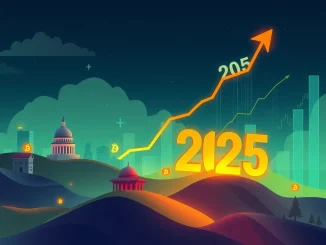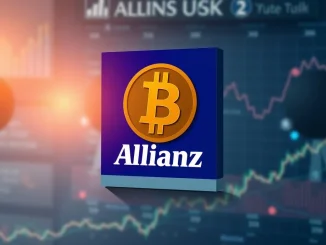
The volatile world of cryptocurrency is always buzzing with activity, and keeping a pulse on market sentiment is crucial for both seasoned traders and newcomers. One key indicator that many crypto enthusiasts keep a close eye on is the Crypto Fear & Greed Index. Provided by Alternative.me, this index acts as a barometer of market emotions, helping to gauge whether investors are experiencing excessive fear or greed. In a recent encouraging shift, the index has shown a notable jump, moving out of the ‘Extreme Fear’ territory. Let’s dive into what this means for the crypto landscape.
What is the Crypto Fear & Greed Index?
Think of the Crypto Fear & Greed Index as a sentiment compass for the cryptocurrency market. It aggregates various data points to provide a single number that reflects the overall emotional climate of the market. This number ranges from 0 to 100, with:
- 0-24: Extreme Fear – This suggests investors are excessively worried, often indicating a potential buying opportunity as assets might be undervalued.
- 25-49: Fear – Still a cautious market sentiment, suggesting some apprehension among investors.
- 50-74: Greed – A more optimistic outlook, indicating increasing investor confidence and potential market growth.
- 75-100: Extreme Greed – Signals excessive optimism, which can sometimes be a warning sign of a market bubble or potential correction.
As of March 12th, the Crypto Fear & Greed Index stands at 34. This marks a significant 10-point increase from the previous day, propelling it out of the ‘Extreme Fear’ zone and into the ‘Fear’ zone. This upward movement indicates a palpable shift in market sentiment, suggesting that while fear still prevails, it’s less intense than before.
Decoding the Index: What Factors Drive Fear and Greed?
The Crypto Fear & Greed Index isn’t based on guesswork. It’s calculated using a weighted average of six different market factors, each providing a unique perspective on investor behavior:
- Volatility (25%): Measures the current and maximum drawdowns of Bitcoin, comparing it with the corresponding average values of the last 30 and 90 days. Unusual volatility can often trigger fear in the market.
- Market Momentum/Volume (25%): Examines the market volume and momentum compared to the last 30 and 90-day averages. High buying volumes can suggest greed, while low volumes during price drops can indicate fear.
- Social Media (15%): Primarily analyzes sentiment on Twitter, particularly for hashtag popularity and engagement. A surge in positive crypto mentions can point towards growing greed, while negative sentiment can fuel fear.
- Surveys (15%): Weekly crypto surveys are conducted, gathering insights into investor sentiment. These surveys directly measure fear and greed levels among participants.
- Bitcoin Dominance (10%): An increasing Bitcoin dominance can sometimes be a sign of fear as investors may be moving away from riskier altcoins and towards the perceived safety of Bitcoin. Conversely, decreasing dominance might suggest growing greed and appetite for altcoins.
- Google Trends (10%): Analyzes Google Trends data for various Bitcoin-related search queries. Spikes in searches like “Bitcoin price manipulation” can indicate fear, while searches for “Bitcoin buy” might signal increasing greed.
Navigating the ‘Fear’ Zone: What Does This Shift Mean for the Crypto Market?
The move from ‘Extreme Fear’ to ‘Fear’ is a noteworthy development. It suggests that the intense bearish sentiment that may have gripped the crypto market is easing. While the market is still in a state of fear, the reduction in extreme fear can be interpreted in several ways:
- Potential Bottoming Out: Extreme fear often occurs during market bottoms. A decrease in extreme fear might indicate that the market is finding a floor and could be poised for a potential recovery or stabilization.
- Reduced Selling Pressure: As fear subsides, panic selling may decrease. Investors might be less inclined to liquidate their holdings at lower prices, which can help stabilize or even push prices upwards.
- Cautious Optimism: The shift to ‘Fear’ doesn’t mean the market is suddenly bullish. It signifies a move towards cautious optimism. Investors are still wary, but the extreme pessimism is diminishing.
- Opportunity for Strategic Investment?: For investors who believe in the long-term potential of cryptocurrency, periods of ‘Fear’ can present strategic buying opportunities. Assets might be trading at discounted prices due to market apprehension.
The Role of Bitcoin in Market Sentiment
Bitcoin, as the leading cryptocurrency, often plays a significant role in shaping overall market sentiment. Its price movements and dominance within the crypto space can heavily influence the Crypto Fear & Greed Index. When Bitcoin experiences price drops, it can trigger fear across the broader crypto market. Conversely, Bitcoin’s rallies can fuel optimism and greed. Therefore, monitoring Bitcoin’s performance is crucial when interpreting the Fear & Greed Index.
What’s Next for Market Sentiment?
While the 10-point jump in the Crypto Fear & Greed Index is a positive sign, it’s essential to remember that the market remains in the ‘Fear’ zone. Further improvements in market sentiment will depend on various factors, including:
- Macroeconomic Conditions: Global economic events, inflation rates, and interest rate decisions can significantly impact investor sentiment in all markets, including crypto.
- Regulatory Developments: Clarity and positive regulatory frameworks for cryptocurrencies can boost investor confidence, while negative regulatory actions can trigger fear.
- Technological Advancements and Adoption: Positive developments in blockchain technology and increasing real-world adoption of cryptocurrencies can contribute to a more bullish outlook.
- Market Events: Unexpected events, both positive and negative, can swiftly shift market sentiment and the Fear & Greed Index.
Actionable Insights: Using the Fear & Greed Index in Your Crypto Strategy
The Crypto Fear & Greed Index isn’t a crystal ball, but it is a valuable tool for understanding market psychology. Here are some actionable insights on how you can use it:
- Gauge Market Mood: Use the index to get a quick snapshot of the prevailing emotional climate in the crypto market.
- Identify Potential Entry/Exit Points (with Caution): Extreme Fear zones might signal potential buying opportunities, while Extreme Greed zones could suggest caution and potential profit-taking. However, remember that the index is not a definitive buy/sell signal and should be used in conjunction with other analysis.
- Manage Risk: Understanding market sentiment can help you manage risk. During periods of extreme fear, consider reviewing your portfolio and risk tolerance. During periods of extreme greed, be mindful of potential market corrections.
- Stay Informed: Regularly monitor the Crypto Fear & Greed Index alongside other market indicators to stay informed about shifts in market sentiment and adjust your strategies accordingly.
Conclusion: A Glimmer of Hope in the Crypto Landscape
The recent rise in the Crypto Fear & Greed Index, moving it to 34 and out of ‘Extreme Fear’, offers a glimmer of hope in the often-turbulent crypto market. While fear still lingers, the reduction in extreme pessimism suggests a potential shift in market sentiment. By understanding and monitoring this index, alongside other market indicators, investors can gain valuable insights into market psychology and make more informed decisions in the dynamic world of cryptocurrency. Remember to always conduct thorough research and consider your own risk tolerance when navigating the crypto market.



